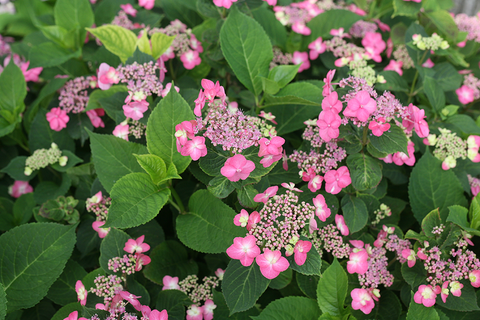Guide to Growing Mountain Hydrangeas

Contents:
Maybe you've never heard of a mountain hydrangea (H. serrata), but you've almost certainly seen one - they are close cousins of the better-known bigleaf hydrangeas and have the same colorful flowers and similar-looking foliage. Mountain hydrangeas grow in the same areas of Japan as bigleaf hydrangeas, but instead of growing along they mild coast, they grow high in the chilly mountaintops. As a result, they have naturally developed better cold tolerance, particularly in their flower buds. This means that if bigleaf hydrangeas don't always bloom reliably for you, a mountain hydrangea might make a much better choice. Though most mountain hydrangeas have lacecap flowers, you'll still enjoy the fantastic blue, purple, or pink color and handsome glossy foliage you seek in bigleaf types.
Hardiness/climate
In terms of USDA hardiness zones, the cold and heat tolerance of mountain hydrangeas is similar to that of bigleaf hydrangeas, zones 5-9. However, cold climate gardeners will likely find that they have much better success getting flowers every year on mountain hydrangeas than they do on bigleaf hydrangeas.
For the very best results, follow similar siting advice for mountain hydrangeas as for bigleaf types: look for sites protected from prevailing cold winds and weather in cold climates, and in hot climates, provide shade during the hottest part of the day.
Size
Because most mountain hydrangeas on the market are relatively recent introductions, you'll tend to see smaller sizes - all of the ones that we offer are under 3' tall. This makes them very easy to use in the garden and should eliminate the need and desire to prune to manage size.
Light
Mountain hydrangeas have slightly narrower foliage than their bigleaf cousins, and that reduction in surface area can make them a bit more resistant to wilting. However, we still recommend shade during the hottest part of the day, particularly in USDA zones 7-9. Sun in the morning, or filtered light all day, is ideal.
Soil
We recommend moist, well-drained soil for mountain hydrangeas for best looks and performance. A 2-3" layer of shredded bark mulch over the roots is recommended to conserve moisture levels in the soil and keep the roots insulated against both hot and cold.
Mountain hydrangeas tolerate acidic to slightly alkaline soils, and their flower color is impacted by soil chemistry as well. Blue to purple/lavender colors develop in acidic soils that contain aluminum, and pink/red colors in other conditions.
Fertilizer
Apply a granular rose fertilizer in early spring, just as the soil begins to thaw in cold climates and any time in early spring in warm areas. Because all of the mountain hydrangeas we offer are rebloomers, you may wish to make additional applications monthly through late July to encourage the vigorous growth that results in the rapid development of abundant new wood flower buds.
Flower Color
Mountain hydrangeas share the color change abilities of bigleaf hydrangeas, and will be pink/red in neutral to alkaline soils, as well as in acidic soils with little to no aluminum. They will be blue/purple in acidic soils that contain aluminum unless otherwise indicated in the description.
As with bigleaf hydrangeas, if you buy a mountain hydrangea online or in a garden center, it will most likely bloom pink unless it was specifically treated to bloom blue. This is because commercial growing media does not contain aluminum. However, a year or so after planting, the flower color will reflect the conditions of the soil you planted it in.
Pruning
Mountain hydrangeas bloom on old and new wood, and as such, pruning should be avoided. They should never be cut or trimmed back, except to remove any dead wood (especially in spring in cold climates). You may safely remove any dead or very old/non-productive stems at the base to increase air flow and enhance the plant's habit.
Mountain hydrangea problems
Mountain hydrangeas are similarly trouble-free as bigleaf types, but as a close relative, may be susceptible to the same problems:
Diseases
Powdery mildew can be managed by providing good air circulation (move any plants that are crowding it), avoiding pelting the leaves with water when you irrigate, and cleaning up any fallen foliage in autumn, as the mildew spores will overwinter on it and re-infect the plant the following spring if conditions are right. If your plant consistently gets powdery mildew in its spot, consider moving it.
Leaf spots like alternaria and cercospora can develop on mountain hydrangeas, though this is generally less likely than on bigleaf types due to the reduced leaf surface. These fungal leaf spots manifest as brownish-purple dots on the leaves, ranging from tiny to quite large. They usually become more apparent later in summer, and particularly if a plant becomes stressed. These diseases can be managed in the same manner as for powdery mildew above.
Insects
Mountain hydrangeas are generally unbothered by insects. Any chewing that is seen typically does not require management of any kind.
Other animals
Slug damage may occur, but tends to be less of an issue on mountain hydrangeas due to their thicker, more leathery foliage and smaller leaf surface. Deer, however, may be an issue, and they are particularly fond of developing flower buds. If deer are an issue in your area, protect plants with a repellent or netting to ensure you get a good bloom.
